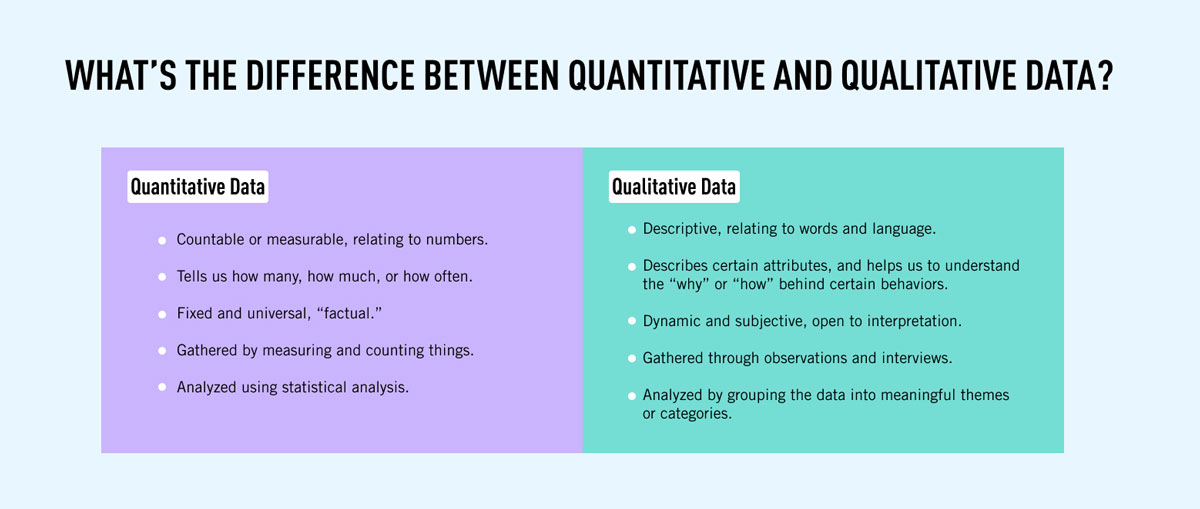Which of the Following Best Describes Qualitative Data
The logic of qualitative data analysis is described as. Generalization to the population b.

Quantitative Vs Qualitative Data What S The Difference
An approach used in qualitative research in which the researcher collects codes and analyzes data simultaneously is.

. Qualitative data can be observed and recorded. Which of the following describes qualitative data. It is ongoing cyclic process integrated into all phases of research.
These are attributes that are rather described than calculated. A qualitative risk analysis requires fast and simple data to complete the analysis. Which of the following is not relevant to analysis of the research problem.
The sum of the relative frequencies must be one assuming no rounding errors. Which of the following best describes qualitative data coding. Recording the temperature of a solid as it is warmed.
Which of the following is characteristic of qualitative research. Which of the following is a feature of a relative frequency distribution. QUESTIONWhich of the following best describes a frequency distribution for qualitative dataANSWERA It groups data into histograms and records the proporti.
Which one of the following statements best describes the requirements for the data type used in qualitative risk analysis. Which of the following describes qualitative data. Which of the following best describes a frequency distribution for quaitative data.
A qualitative risk analysis encourages biased data. It is an ongoing cyclic process integrated into all phases of research. Which of the following best describes qualitative data analysis 1 See answer EmmyOceanGacha EmmyOceanGacha Answer.
It is begun after all data has been collected. Qualitative data describes the data analyzed through quantitative analysis. Taking the mass of an object using a balance.
A qualitative risk analysis encourages biased data to reveal risk tolerances. The tendency in qualitative research to derive a complex array of data from a variety of sources using a variety of methods is referred as. To prove a particular theory.
B It groups data into intervals called classes and records the proportion fraction of observations in each class. Uhm Im sorry but where is your question. Which of the following describes the disciplined inquiry of qualitative research.
It begins after all data has been collected C. In qualitative research coding is how you define what the data you are analysing are about Gibbs 2007. Phenomenology has its disciplinary origins in.
The research emphasizes the voices of participants. To explore the meaning of peoples experiences culture etc. Which of the following best describes qualitative data analysis.
Qualitative data in statistics is also known as categorical data data that can be arranged categorically based on the attributes and properties of a thing or a phenomenon. It is an awkward haphazard process. Unique case orientation d.
It is an awkward haphazard process. Which of the following best describes a frequency table. Which of the following best describes qualitative data analysis.
It is an ongoing inductive cyclic process integrated into phases of the research process. In this case the answer is. What is coding qualitative data.
The data type used in qualitative risk analysis. It begins after all data has been collected. The primary data analysis approach in ethnography is.
Im really sorry I cant help you but thanks for the. To test hypotheses of the study. A qualitative risk analysis required unbiased stakeholders with biased risk tolerances.
Which of the following best describes the process of qualitative data analysis. Which of the following best describes qualitative data analysis. Fre e points uahsuebh sh sb New questions in English.
It builds from abstraction to specific concrete examples. It is an awkward haphazard process. It groups data into categories and records the number of observations in each category.
Which of the following is not true about hypothesis. Numerically representing the concepts identified by the participants. Dividing data in parts that represent single thoughts.
Noting cloudiness occurs when two solutions are mixed. It is ongoing cyclic process integrated into all phases of research 5. Qualitative data is defined as the data that approximates and characterizes.
Whic of the following best describes the purpose of conducting a qualitative research. The research is investigative. To examine relationships of variables.
Qualitative data is also called categorical data since this data can be grouped according to categories. A qualitative risk analysis requires fast and simple data to complete the analysis. Issue to be considered for the secondary data include which of the following.
Qualitative data refers to the color texture olfactory and sensory attributes. The process of moving from observationsdata towards generalizations hypotheses or theory is called. Standardized tests and measures 2.
It builds from abstraction to specific concrete examples. All of the above. A grouping of qualitative data into classes showing the number of observations in each class.
Adding all of the scores together and describing them statistically. This data type is non-numerical in nature. It builds from abstraction to specific concrete examples.
Identify data segments that contain general episodes. A qualitative research design in which data related to past events is systematically collected and evaluated to describe potential causes effects or trends related to those events is known as. The research is rigorous in terms of data collection and analysis.
A qualitative risk analysis requires accurate and unbiased data if it is to be credible. Questions and Answers. It groups data into histograms and records the proportion fraction of observations in each B.
A It groups data into histograms and records the proportion fraction of observations in each histogram. Measuring the volume of an object by water displacement. 1 Which of the following best describes a frequency distribution for qualitative data.

6 Types Of Qualitative Research Methods Qualitative Research Methods Research Methods Research Skills

Qualitative Data Analysis Methods And Techniques Data Analysis Activities Data Analysis Software Qualitative Research Methods

Qualitative Vs Quantitative Data Collection Methods Social Science Research Research Methods Psychology Studies
Comments
Post a Comment